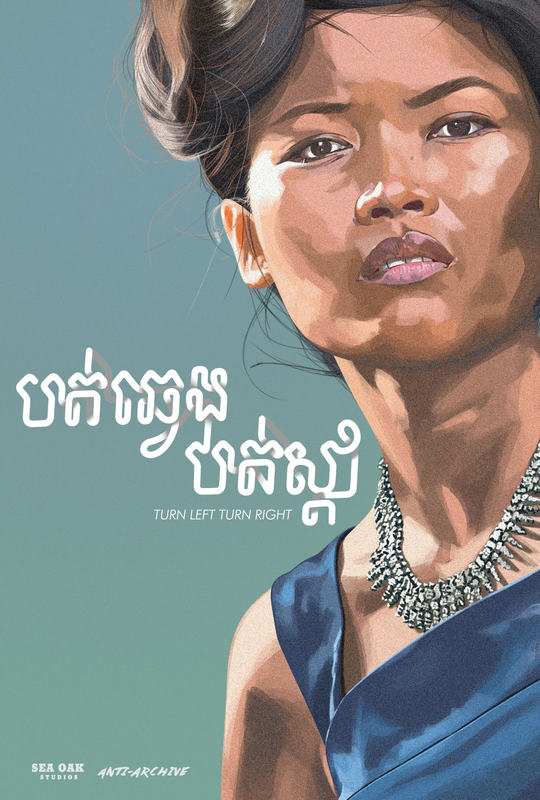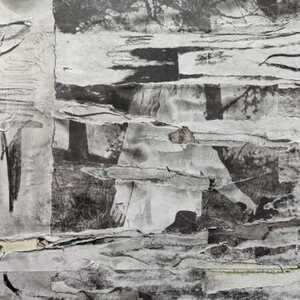
Turn Left Turn Right
directed by Douglas Seok
starring Kanitha Tith
On few occasions, when witnessing a central character’s actions without dialog, can we begin to form an opinion of that particular character’s overall ethos and intentions and how that character connects to the narrative of the film. When Turn Left Turn Right begins, we see Kanitha (Kanitha Tith), a quintessentially modern looking woman, decked out in her royal blue cocktail dress. Kanitha has a raw, almost childlike intensity to her stare and stance as she wanders quietly through the ruins of Angkor Wat while Khmer era music plays in the background. As the screen fades to black, the song continues, and you are presented with a title card announcing the beginning of “Track Two” and then the image of actress Dy Saveth, the star of the international 1970 fantasy hit, The Snake Man, and one of the few stars remaining from the Golden Age of Khmer Cinema, dancing to the same song that introduced us to Kanitha, who we now see watching the video of Saveth. Kanitha is taking a break from her unglamorous job as a waitress in a rock club, where she slightly bobs her head to the music while going through the motions of work, before ending her shift and riding home to fall asleep in her work clothes on a mat next to her sleeping grandfather. End of track two.
Within these early tracks, for his second feature, American-born director Douglas Seok establishes his commitment to an unconventional narrative structure analogous to that of a concept album, a method that allows movement and texture and the response to rhythm and melody to supercede dialog in allowing you unfiltered access into the mind and emotions of Kanitha, the film’s central character. It would be easy to dismiss Turn Left Turn Right as an “atmospheric exercise,” which was the fate that befell Hou Hsiao-hsien’s 2001 feature, Millennium Mambo, a film that similarly took us through the days of a woman in her twenties as she tries to suss out an existence in a place where the past eras serve as an impediment and where some archaic familial attitudes still exist. The reality of that past emerges as track three begins, when we again see Kanitha in the ruins at Angkor Wat clad in her blue dress, except now she is carelessly and joyfully dancing in a way that is completely her own to a classic Cambodian rock tune playing behind her. Here, the single camera full frame static shot with a touch of Technicolor is reminiscent of the films of the Khmer era, creating a distinct visual contrast from the moments of Kanitha’s reality, which are shot with standard, in motion HD video that is common to the language of contemporary cinema, suggesting that in her dreams, Kanitha is trapped in between the past and the present.
[[Kanitha Dancing]].
Kanitha has two jobs: one as a waitress in the aforementioned nightclub and another as a hotel clerk, but she must still live with her grandfather and mother, who continue to badger Kanitha about her unmarried status and her lack of desire to create a family of her own. In the eyes of her family, Kanitha’s lifestyle may appear selfish, but her desire to remain outside of traditional roles appears justified when we witness the economic struggles of her friends and their lives in the marketplace. When her grandfather becomes ill, Kanitha and her mother discuss using their small amount of savings just so Kanitha’s grandfather can be treated in a hospital. Faced with such a grim financial future, Kanitha continues to work her jobs, but the dancing that once only occurred in her dreams, begins to find an unwelcome home in the reality of her day to day urban existence. It is only through her trips into the natural settings of waterways and her friend’s farm that Kanitha can finally feel unencumbered by the world around her enough to share her desire for freedom with others.
In his short, but complete sixty-eight minute second feature, director Douglas Seok creates a compelling and elegant visual narrative that intertwines scenes from a rapidly changing modern life with glimpses into an era of Cambodia that has long since passed. Seok also mixes in contemporary and Khmer era vintage songs, minimal dialog, and physical expression, which altogether with the images allows his protagonist to delve deeply into a dream state without ever losing focus of the film’s essential central construct of creating a character whose choices are influenced by the conflict between her own desire to live a simpler life because of the complexity of today and the expectations and needs of the people she loves who are fundamentally connected to traditional values from a time that no longer exists.
Turn Left Turn Right Official Site:












